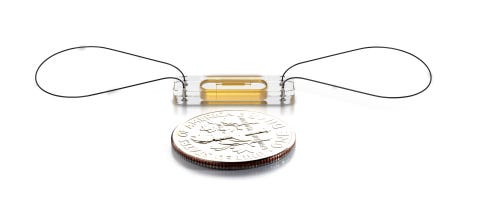Why MEMS Have a Square Peg, Round Hole Problem
April 3, 2015
One of the biggest challenge of integrating MEMS into medical devices lies in their form factor.
Brian Buntz
|
MEMS technology is featured in St. Jude's CardioMEMS HF System, which is the first FDA-approved heart failure monitor shown to significantly cut hospital admissions related to heart failure. |
Used in everything from implantable heart-failure monitors to cutting-edge diagnostics, microelectromechanical systems (MEMS) can give medical devices sophisticated sensing capabilities. Medical device designers have used MEMS in products such as blood pressure cuffs and respiratory equipment since the 1980s. The next medical frontier for MEMS, however, is within the human body. Recent devices using MEMS pressure sensors include catheter tip sensors, disposable implantable blood-pressure monitors for use during surgery, and an implantable device that measures pulmonary-artery pressure and heart rate.
Yet the rectangular "Manhattan geometry" that is typically used to produce the silicon wafers used for MEMS is a challenge. Designers are faced with the prospect of putting a round peg (a rigid, brittle wafer) into a round hole (a flexible tube). "If you are trying to put a sensor in the human body, chances are you want it to go into a soft, flexible material and that is most likely going to be a tube," observed Alissa M. Fitzgerald, PhD, founder of AMFitzgerald & Associates (Burlingame, CA) at the Bay Area Biomedical Device Conference at San Jose State University.
"The challenge of putting a square brick into a tube amounts to roughly 70% of the unit cost," Fitzgerald said. "The sensor itself is actually not the most expensive part of the device but the cost comes from how it is put into the device package."
Device designers incorporating MEMS in invasive or implantable applications must worry about a whole host of items. Examples include mechanical stress, fracture, and electrical interconnect. And then you have to deal with things like moisture, radiation from x-rays, magnetic fields in MRI, and sterilization. "And also we have to think about biocompatibility. Silicon's biocompatibility for long-term implants has not been established," she explained. "You can't have a bare MEMS chip exposed. And the edges of the chip are sharp."
If the rectangular geometry of MEMS is so difficult, what about putting them on hexagonal or round wafers? While it is possible to do either, it is much easier and less expensive to dice silicon wafers into rectangles. "We use a saw that looks a lot like a fancy tile saw. While there are some laser technologies that can make whatever shape you like, they are expensive and that is why you don't see them used very commonly. Making circles is really challenging, but it can be done," Fitzgerald explained.
The subject relates to an issue that all medical device makers must face when planning on incorporating MEMS into their products: should you buy the MEMS you need or make it?
While there are many MEMS available commercially, many are not suited for use in life-critical systems or invasive medical applications. "Also, some of them are sized for electronics going into phones and cars--not in the human body," Fitzgerald said.
While making custom MEMS is possible, that is generally an expensive and time-consuming option. The development cycle can take a few years. And depending on the complexity of the sensor, the price tag can be in the range of several million dollars.
Another strategy is to take off-the-rack MEMS and to customize it for your application. "It is similar to an off-the-rack suit. It is mostly put together but you need to tailor it for your purposes," Fitzgerald explained. This can be an attractive option as it enables device makers to customize MEMS without spending a fortune and waiting years before it is ready to use.
Refresh your medical device industry knowledge at BIOMEDevice Boston, May 6-7, 2015. |
Brian Buntz is the editor-in-chief of MPMN and Qmed. Follow him on Twitter at @brian_buntz.
Like what you're reading? Subscribe to our daily e-newsletter.
About the Author(s)
You May Also Like


.png?width=300&auto=webp&quality=80&disable=upscale)
